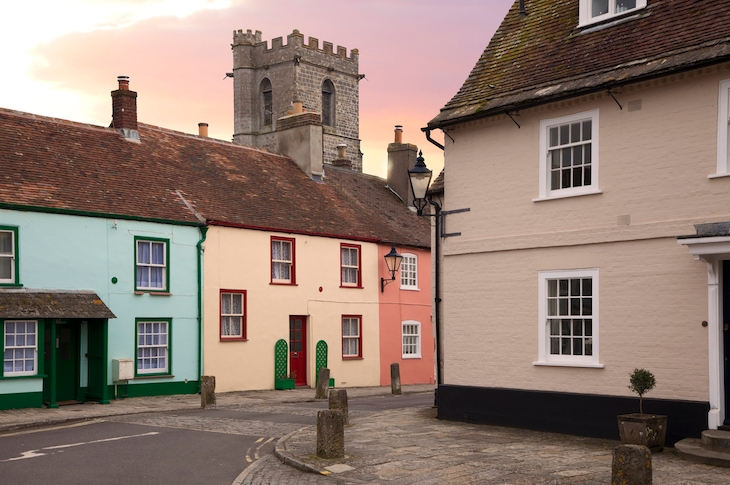Holy smoke! The sleepy old Church of England is a greedy, money-grubbing property tycoon. This month, it emerged that since 2010 the church has laid claim to minerals under 585,000 acres of land, including territory it doesn’t actually own. Its current holdings amount to only 105,000 acres, but it retains the underground mineral rights to vast areas that used to belong to the church.
And it’s making damn sure it retains those rights. The church has sent letters to thousands of people, telling them they don’t own the gilt-edged minerals below its land. In its defence, the church says it’s just doing its statutory duty in registering the rights. But all the same, it’s the latest in 1,400 years of buccaneering property ventures for the English church, going back to 597 ad, when St Augustine built Canterbury Cathedral on a prime piece of Kent real estate. St Paul’s Cathedral, founded in 604 ad, followed soon afterwards. Over the next 900 years, the church built almshouses, nunneries, monasteries, abbeys, bishops’ palaces, schools, hospitals, and thousands of churches and cathedrals, scooping up millions of acres. Just before the Reformation, the church owned a third of the land in England.
You can still see the ghost of the great Catholic pre-Reformation landholdings across the country today: 99 per cent of surviving pre-Reformation buildings are churches, cathedrals or monasteries. Parish churches, usually built before the Reformation, often remain the largest buildings in an English village and their spires tend to be the tallest structures.
That massive property portfolio was ransacked by Henry VIII in the biggest single property transfer in British history. He smashed up the monasteries and handed over chunks of land to his noble pals. Many aristocratic estates today were owned by the church before the Reformation. Woburn Abbey, the Duke of Bedford’s seat, was a Cistercian abbey given by Henry VIII to the duke’s ancestor, the first Earl of Bedford, in 1547. Downton Abbey, were it real, would have been a church property before the Earl of Grantham got his hands on it. Henry VIII nabbed the juiciest church land and buildings for himself. He took Hampton Court and York Place (later Whitehall Palace) from Cardinal Wolsey. Hyde Park, Kensington Gardens and Regent’s Park had belonged to Westminster Abbey and Barking Abbey. Henry made them his personal hunting parks.
But even he couldn’t take everything from the newly created Church of England. As recently as 1873, the church still owned 2.13 million acres. Over the last 150 years, it has sold thousands of parsonages, rectories and vicarages and more than two million acres, usually at rock-bottom prices.
The church momentarily got its act together after the war thanks to the late Lord Rayne, a property developer married to Lady Jane Vane-Tempest-Stewart, Lady Annabel Goldsmith’s sister and one of the Queen’s 1953 Coronation maids of honour. In 1956, the church was about to sell 65 acres of prime central London near Paddington Station — part of the 500-acre Hyde Park Estate, in church hands since the Middle Ages. Max Rayne stepped in to stop the sale, arguing that the church would be better off developing the land with him. He was quite right. In 1985, the church sold the three-block row of office buildings it had developed for £12 million, 30 times its estimated auction value in 1956.
In a 1958 joint property deal between Rayne and the Church Commissioners (who look after the Church of England’s property), they bought 5.5 acres on Tottenham Court Road. They sold them in 1966 for £11 million, earning a £7 million profit. The church eventually got into hot water for doing so well out of the Hyde Park Estate, particularly when the area became gentrified and the working classes could no longer afford to live in the newly developed properties.
To be fair to the church, it has to walk a difficult tightrope between sweating its assets and providing reasonably priced housing for its parishioners. And it has to pay its employees and their pensions out of its own portfolio. Few vicars can rely on the collection plate alone to pay a living wage.
The Church Commissioners managed to pay vicars’ stipends out of income until the early 1990s, when they made a series of disastrous property deals. In 1992, they lost £800 million of their £3 billion port-folio. They had taken out vast borrowings to finance speculative property developments. Those borrowings rose from £4.7 million in 1987 to £518 million in 1990 as interest rates soared. For the first time in history, the Commissioners’ expenditure on vicars’ stipends and pensions exceeded their portfolio income. The church took another hit in the 2008 financial crash and these losses meant they had to raise the retirement age for the clergy.
Over the past decade, though, as property and equities have soared in value, the Church of England’s bank balance has swollen again. In 2014, it sold its share of the Pollen Estate in Mayfair — land around Savile Row and Cork Street that the church had owned for centuries — for £381 million.
Today, it has nearly £8 billion in assets. It runs 4,700 schools and owns 16,000 churches in England, along with tracts of land in cathedral cities such as Canterbury, Ely, Peterborough and York. In 2014, it bought 50 acres in Peterborough, 121 acres in Carlisle, 765 acres in Kent and 17,000 acres of forests in Wales and Scotland. Its tentacles spread abroad, too: in 2014, the church bought retail and residential land in Michigan and California, 27,000 acres of forest in Virginia, and land for sandalwood plantations in Australia’s Northern Territory.
Nearly half a millennium after Henry VIII asset-stripped the English church, it remains a mighty property tycoon, both underground and overground.
Harry Mount and Damian Thompson discuss the Church’s property portfolio on The Spectator Podcast.






Comments